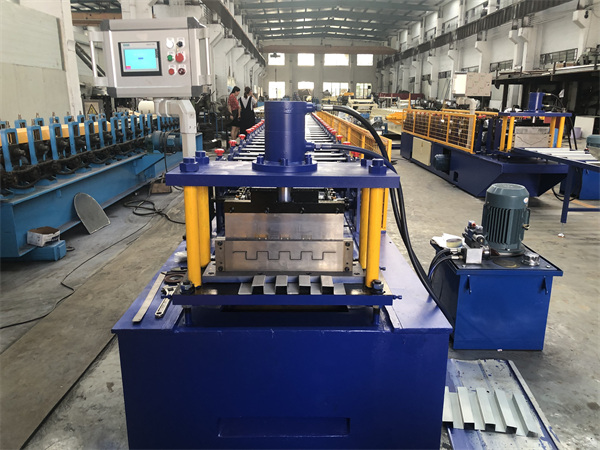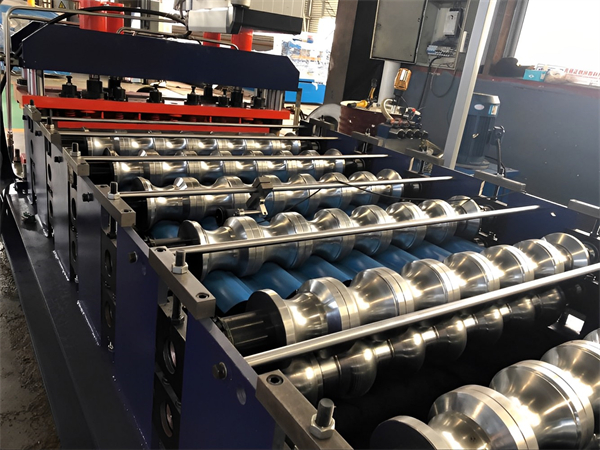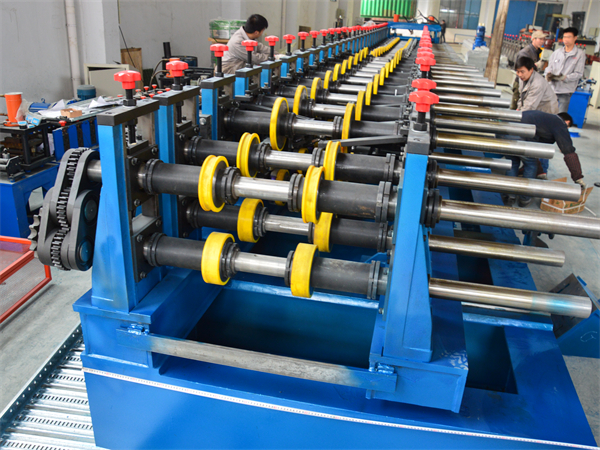Roll forming is a metal forming process used to produce long sheets or profiles with constant cross-sections. A профилегибочная машина progressively forms sheet metal or strips through a series of roller dies. The process is versatile, efficient and economical for producing high volumes of standardized parts. This guide provides a detailed overview of roll forming machine types, key components, technical specifications, and best practices for selection, operation and maintenance.
Overview of Roll Forming Process and Machines
Roll forming machines are available in different configurations to produce various profiles and cross-sections. The roller dies bend the material incrementally as it passes through successive stands to gradually shape the profile. The key aspects are:
Типы машин для формовки рулонов
| Тип машины | Описание |
|---|---|
| Одиночный профиль | Produces single profile constantly |
| Multi-Profile | Switchable heads for different profiles |
| Портативный | Compact for on-site or mobile operation |
| Обычай | Tailored for special profiles |
Components of Roll Forming Machine:
- Roller dies – Formed into successive stands to gradually bend sheet
- Forming stations – Houses roller dies for sequential bending
- Decoiler – Feeds raw coil material into machine
- Feed mechanism – Controls material feed speed and tension
- Rollers – Provide support and configure material flow
- Cutoff device – Cuts finished profiles to length
Roll Forming Machine Specifications
The technical specifications of roll forming equipment determine their capability and production capacity. The key parameters to consider are:
Roll Forming Machine Design Specifications:
| Спецификация | Подробности |
|---|---|
| Rolling Length | Length of rollers and maximum profile length |
| Rolling Width | Width between rollers and maximum material width |
| Rolling Thickness | Thickness range of raw material supported |
| Станции формовки | Number of stands for progressive bending |
| Размер ролика | Diameter and width of rollers |
| Материал ролика | Steel, alloy steel etc. |
| Тип ролика | Horizontal, vertical, inclined, pyramid etc. |
| Тип привода | Electric, hydraulic, servo, combination |
| Speed Range | Minimum and maximum rolling speed |
| Система подачи | Uncoiler, feed rolls, pinch rolls etc. |
| Cutting Mode | Shearing, sawing, laser cutting etc. |
| Инструментальная оснастка | Quick changeover, modular, custom etc. |
| Автоматизация | PLC controls, motion controls, sensors etc. |
Performance Specifications:
| Параметр | Типовые значения |
|---|---|
| Скорость прокатки | 10 - 100 м/мин |
| Уровень производства | Up to 120 m/min |
| Точность | ±0.5 mm over 3 m length |
| Повторяемость | Excellent due to progressive dies |
| Отделка поверхности | Smooth, marks possible at cut |
Operational Requirements:
| Элемент | Подробности |
|---|---|
| Мощность | 20-100 kW connected load |
| Air Pressure | 5-8 bar for pneumatics |
| Персонал | 1-2 semi-skilled operators |
| Космос | Length > 15m. Width > 4m, Height > 3m |
The specifications vary widely depending on the profile, materials and production volumes. Custom machines can be built to suit specific requirements.

Roll Forming Machine Design and Working
The design aspects and working principle of roll forming machines are:
Machine Structure
- Heavy base frame for stiffness
- Overhead support stand for forming stations
- Inline configuration for material flow
- Lateral or vertical split housing for accessibility
Роликовые штампы
- Made of machined alloy steel
- Mounted on shafts in forming stands
- Arranged horizontally, vertically or at angle
- Ground and hardened to close tolerances
- Quick changeover design for flexible production
Станции формовки
- House combination of top and bottom rollers
- Roller shafts mounted on bearings
- Adjustable roller mounts and spacers
- Guide rails for precise die positioning
Система подачи
- Decoiler or sheet feeder at start
- Servo motors and drives for speed control
- Pinch rolls for positive grip without slippage
- Dancer arm for maintaining web tension
- Anti-wicking rolls to prevent deformation
Приводы
- Electric servomotors and drives
- Hydraulic drives for high torque
- Precision speed and tension control
- Independent drives for roller shafts
- Synchronized using master encoder
Система контроля
- PLC or industrial PC control
- HMI touchscreen for interface
- Roll gap and speed settings
- Servo drive synchronization
- Safety interlocks and auto stop
Принцип работы
- Sheet or coil fed into roller dies
- Progressive bending occurs in steps
- Bottom rollers provide counterforce
- Material exiting with finished profile
- Cut to length by saws or shears
Through the coordinated motion of the precisely machined roller dies, the strip material is gradually shaped into the desired cross-section by the roll forming process.
Roll Forming Operation
| Шаг | Операция |
|---|---|
| 1 | Coil stock fed into feed rolls |
| 2 | Material progressively shaped by roller dies |
| 3 | Bottom rollers provide counterforce |
| 4 | Profiling achieved incrementally |
| 5 | Formed section flows through machine |
| 6 | Cutoff device cuts finished profile |
Области применения и обслуживаемые отрасли
Roll formed sections find widespread usage across industries due to their continuous production, lightweight properties, high strength and corrosion resistance.
Application Areas of Roll Formed Products:
| Категория | Продукция |
|---|---|
| Structural profiles | Roofing sheets, wall panels, liner trays, studs, joists, beams |
| Storage products | Racking, shelving, lockers, wardrobes |
| Furniture parts | Frames, enclosures, shelving, legs |
| Automotive parts | Trim, sealing, bumpers, roof rails, tubes |
| Приборы | Panels, enclosures, wrappers, frames |
| Воздуховоды ОВК | Rectangular and spiral ducts |
| Сельскохозяйственные здания | Cladding, roofing, structural frames |
Industry-wise Applications
| Промышленность | Application Products |
|---|---|
| Строительство зданий и сооружений | Cladding, decking, purlins, roofing, doors, railing |
| Автомобильная промышленность и транспорт | Body panels, roof rails, seat frames, bumpers |
| Электротехника и электроника | Enclosure panels, chassis, distribution boxes |
| Consumer Appliances | Washing machine drums, refrigerator liners, exterior panels |
| Ventilation and Air Conditioning | Spiral ducts and fittings, smoke exhausts |
| Инфраструктура | Guard rails, lighting poles, sign boards, solar frames |
| Мебель | Cabinet doors, table legs, shelving, storage racks |
Roll formed sections enable lightweight, high strength structures across industrial and commercial applications.
Benefits and Advantages of Roll Forming Process
Roll forming offers significant benefits compared to other forming methods:
Преимущества роликовой формовки
| Параметр | Преимущества |
|---|---|
| Капитальные затраты | Lower than stamping or press brakes |
| Operating Cost | Low power consumption, minimal wastage |
| Уровень производства | Up to 10x faster than manual methods |
| Труд | Requires semi-skilled operators |
| Переналадка | Roller dies enable fast profile switches |
| Гибкость | Easy to change dimensions and materials |
| Точность | Последовательные и воспроизводимые профили |
| Отделка поверхности | Smooth, bright finish possible |
| Прочность | Cold forming work hardens the metal |
| Легкий | Thin and lighter structures possible |
| Simple Operations | User friendly controls and automation |
| Безопасность | Well guarded moving parts |
Key factors driving adoption of roll forming include high productivity, flexibility, superior quality, and cost efficiency.

Типы профилегибочных машин
Roll forming machines are available in different configurations designed for specific production needs:
Типы машин для формовки рулонов
| Машина | Описание |
|---|---|
| Longitudinal Line | For high volume panel production |
| Portable Rollformer | Lightweight and mobile operation |
| Multi-Profile Machine | Quick profile changeover |
| Double Head Rollformer | Более высокие темпы производства |
| Pyramid Type | Bi-directional forming capability |
| Custom Rollformer | Engineered for special profiles |
Longitudinal Line
- Inline production line
- Decoiler, accumulator, forming mills, cutoff
- Lengths over 25 m
- Parts warehouse integration
- For high volume sheet production
Portable Rollformer
- Compact and movable
- Trailer or truck mounted
- For on-site production
- Flexible positioning
- Lower capacity
Multi-Profile Machine
- Computer controlled stations
- Quick die changeover
- Multiple pre-loaded profiles
- For lower volume flexibility
Double Head Rollformer
- Two side-by-side forming lines
- Independent speed control
- Higher production rate
- Redundancy for uptime
Pyramid Type
- Bi-directional roller configuration
- Better support during forming
- Prevents part twisting
- For symmetrical sections
Custom Rollformer
- Engineered for unique profile
- Special roller design
- Dedicated production
- For proprietary sections
The choice depends on the required throughput, profile complexity, changeover needs and production volumes.
How to Choose a Roll Forming Machine
The key factors to consider when selecting a roll forming machine are:
Roll Forming Machine Selection Criteria
| Параметр | Соображения |
|---|---|
| Форма профиля | Dimensional specs, radii, angles |
| Материал | Steel, aluminum grades and thickness |
| Уровень производства | Hourly or annual volume required |
| Длина | Maximum part length needed |
| Ширина | Available working width and space |
| Инструментальная оснастка | Standard or custom roll dies |
| Средства управления | Ease of programming and settings |
| Уровень автоматизации | Material handling and speed control |
| Line layout | Inline or transverse arrangement |
| Производительность | Speed, precision, surface finish |
| Безопасность | Guarding, emergency stops |
Critical Factors
- Profile drawings with complete specifications
- Annual or daily production volume
- Operating shifts per day
- Raw material type and thickness
- Accuracy and finish requirements
- Available space for machine
- Уровень квалификации оператора
- Expandability for future
Consulting with roll forming experts is highly recommended when specifying machines for the first time or for large production scale. Getting the requirements right is key to maximizing productivity and total cost of ownership.
Производители оборудования для формовки рулонов
Some of leading global manufacturers of roll forming equipment are:
Основные производители валковых формовочных машин
| Компания | Расположение |
|---|---|
| Группа Брэдбери | США |
| Formtek | США |
| Gasparini SpA | Италия |
| Ханчжоу Ролл Форминг Машин | Китай |
| Howick Ltd. | Новая Зеландия |
| Metform | Турция |
| Robor Corp | США |
| Rollvis SA | Switzerland |
| Разработка технологических процессов формообразования | Индия |
Capacities and Models
- Production up to 180 m/min
- Width up to 2.5 m
- Quick die change modular stands
- Single, dual and multi-profile machines
- Standard and custom roll former designs
When sourcing roll forming machines, consider manufacturers offering:
- Wide model range and customization
- Local sales and service support
- Новейшие технологии и возможности
- Training and maintenance programs
- Overall life cycle value and TCO
Choosing an established manufacturer can ensure access to service, parts, upgrades and process support throughout the machine lifecycle.
Ценообразование на рулонных формовочных машинах
Цены на рулоноформовочные машины варьируются в зависимости от:
Факторы, влияющие на стоимость
- Type and size
- Скорость производства
- Особенности автоматизации
- Controls and drives
- Мощность по толщине материала
- Проектирование оснастки
- Manufacturer’s brand and location
Typical Cost Ranges
| Тип машины | Диапазон цен |
|---|---|
| Entry level portable | $40,000 to $100,000 |
| Single profile machines | $100 000 - $500 000 |
| Multi-profile machines | $250,000 to $1 Million |
| High speed longitudinal lines | > $1 Million |
| Нестандартные валковые формовочные машины | Application dependent |
Additional Cost Items
- Design engineering charges
- Tooling cost for profile
- Shipping and customs
- Installation and commissioning
- Training for operators
- Инвентарь запасных частей
Large production lines with warehouse integration, automation and custom features can cost over $2 million. Getting quotes from different vendors is advised.

How to Operate and Maintain Roll Forming Machines
Proper operation and preventive maintenance are essential for productivity and longevity of roll forming machines:
Эксплуатация рулонных формовочных машин
| Деятельность | Описание |
|---|---|
| Planning | Schedule production, ensure material availability |
| Инспекция | Check rollers, safety devices, lubrication |
| Программирование | Input correct profile, speed, length |
| Set up | Position guides, inserts, cutoff |
| Jog mode | Inch to test run slower speed |
| Работа | Monitor forming, speed, sensors |
| Качество | Verify first piece dimensional accuracy |
| Безопасность | Ensure guards in place, no unsafe conditions |
- Wear gloves and eye protection when handling sheet metal
- Adjust machine parameters gradually and systematically
- Clean oil spills immediately to prevent slips
- Report any abnormal noise, vibration or behavior
Maintenance Checks
| Система | Задачи технического обслуживания | Частота |
|---|---|---|
| Ролики | Inspect surface damage | Еженедельник |
| Подшипники | Lubricate roller shaft bearings | Ежемесячно |
| Приводы | Check belt tension and alignment | Ежемесячно |
| Guards | Ensure in place and functional | Ежедневно |
| Гидравлика | Check oil level and leaks | Ежемесячно |
| Electrical | Inspect connections, covers | Ежеквартально |
| Структура | Check loose fasteners | Ежемесячно |
| Безопасность | Test emergency stops and sensors | Ежеквартально |
Proactive maintenance as per manufacturer’s recommendations is vital for maximum uptime and extending machine life. Keep records of all inspections, repairs and parts replacements.
Советы по безопасности при прокатке
Roll forming operations involve moving machinery and sheet metal handling which require safety measures:
- Restrict access for only trained personnel
- Ensure proper machine guarding is in place
- Never reach into unsafe areas during operation
- Выполните процедуры блокировки перед обслуживанием
- Wear cut resistant gloves when handling sheet metal
- Keep work area clean and uncluttered
- Never stand in line with material flow path
- Maintain adequate lighting in the production area
- Know emergency stop button locations
- Report any unsafe electrical, mechanical or hydraulic conditions
- Never modify or override safety mechanisms
- Formalize safety procedures and training
Making safety a priority protects personnel and equipment during roll forming operations.
Roll Forming Machine Troubleshooting
Some common issues faced in roll forming machines and remedies are:
Roll Forming Problems and Solutions
| Выпуск | Возможные причины | Корректирующие действия |
|---|---|---|
| Inaccurate profile | Worn rollers, loose shafts | Realign/replace rollers, tighten shafts |
| Scratched finish | Debris, damaged rollers | Clean rollers, replace damaged ones |
| Чрезмерная вибрация | Imbalance, loose parts | Tighten loose parts, rebalance rollers |
| Утечки в гидравлической системе | Worn seals, damaged hoses | Replace seals, damaged hoses |
| Speed variation | Slipping belts, sensor issue | Adjust belt tension, check sensor |
| Uneven material feed | Worn/slippery feed rolls | Replace feed rolls, increase tension |
| Замятие листа | Misaligned guides, worn rollers | Realign guides, replace worn rollers |
Consult the machine manual and manufacturer if faults cannot be resolved. Stop operation immediately in case of any safety issues.
Roll Forming Machine FAQs
В: Какие материалы можно подвергать рулонной формовке?
A: Most ductile metals like steel, stainless steel, aluminum, copper, brass. Thickness under 3 mm is common.
Q: What profile shapes are possible?
A: C, U, Z, hat, tube, angle, channel, rails, bars etc. Complex beads and louvers also possible.
Q: How to calculate production rate?
A: Production rate in ft/min = Machine speed (ft/min) x Number of heads
Q: What tolerances are achievable?
A: +/- 0.5 mm over 3 m length is typical. Tighter tolerances possible with precision rollers.
Q: How many operators are needed?
A: 1-2 operators for typical operation. Automated lines may need none.
Q: Is surface coating possible after roll forming?
A: Yes, powder coating and other finishes can be applied after roll forming.
